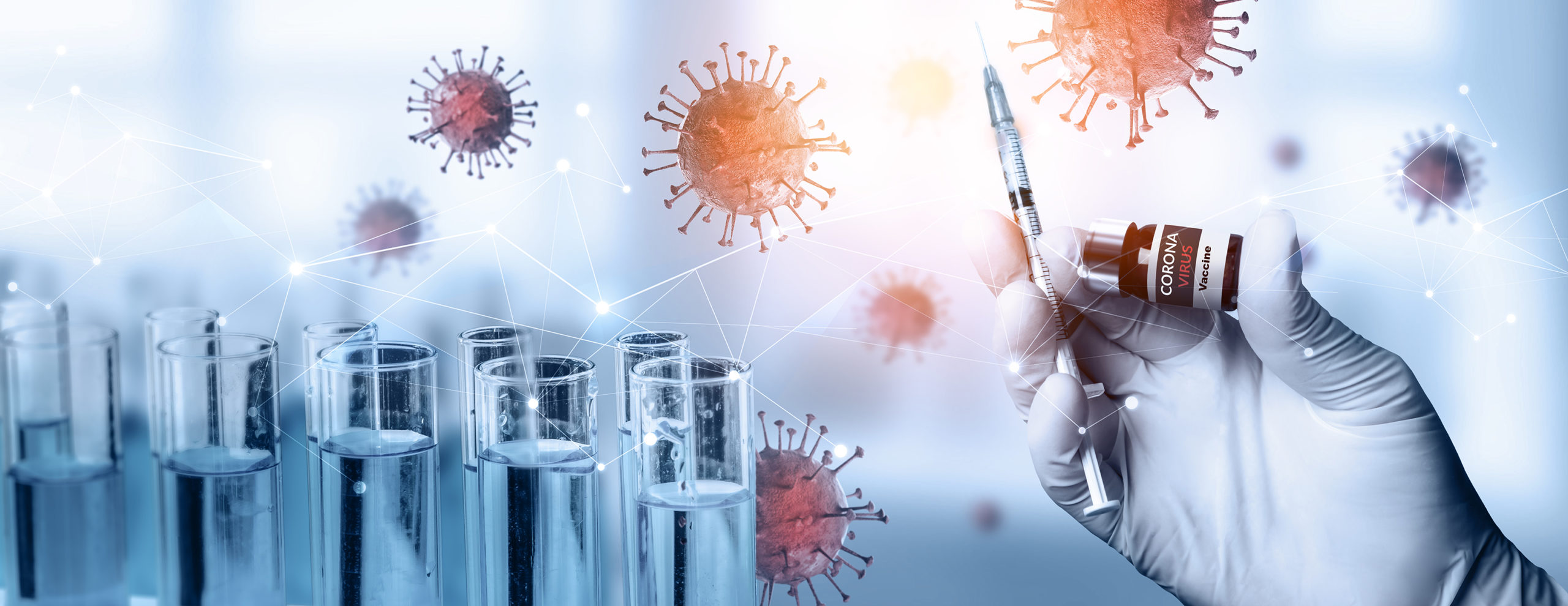COVID-19 Vaccines: Here’s Where We Are

As reports of effective COVID-19 vaccines hit the news, more of us are seeing the proverbial light at the end of the pandemic tunnel. Vaccines have long been considered a major weapon against infections, and the three that have announced successful Phase 3 trials are no exception.
Nevertheless, public health experts and the physician-scientists participating in the clinical trials have a warning: Don’t let your guard down. COVID-19 will hang around even after you get the much-needed shot in the arm.
“It’s a huge victory in the effort to prevent disease and it provides a way forward for us,” says Susanne Doblecki-Lewis, M.D., an infectious disease specialist with the University of Miami Health System. “We have to keep in mind that it won’t stop the spread, but it will help.”
Tempering the jubilation with a little reality is what Dr. Doblecki-Lewis and her colleagues know to do. As the lead researcher of a clinical trial that tested the Moderna vaccine at UM’s Miller School of Medicine, she is well aware of the benefits — and limitations — of inoculations. What’s more, “there’s still a lot we don’t know,” she says. “We focus on the efficacy but we also need to remember that we have to figure out how to best get it to people.”
Stopping the spread of misinformation
Olveen Carrasquillo, M.D., a primary care physician at the University of Miami Health System, is concerned by some of the misinformation about potential vaccines that could lead to people refusing to get the essential shots. (Experts estimate that between 50 to 70% of the population must get inoculated to stop the spread.) “Much of what we do is give people the correct information. I have heard many types of misconceptions and some of it is wild,” he says.
So far, three vaccines have reported promising results in the U.S. and U.K. The first one to do so was the Pfizer/ BioNTech candidate, which recently applied for emergency use authorization with the U.S. Food and Drug Administration. It prevents up to 95% of COVID-19 infections, researchers said. The Moderna candidate also reports about a 95% efficacy rate. The two require a booster shot several weeks apart.
The downside? Both need highly specialized storage. Pfizer’s vaccine must be kept at minus 70 degrees Centigrade, Moderna at minus 20 degrees Centigrade. This is significantly colder than most vaccines and is likely to pose a problem in distribution, particularly in rural areas and undeveloped countries.
The third potential vaccine, the AstraZeneca/University of Oxford candidate, had an average 70% efficacy rate, but that went up to 90% with a two-dose regimen. Unlike the other two, it doesn’t require such low freezing temperatures, only refrigeration. It’s also cheaper and easier to distribute.
When can I get a vaccine?
If these receive approval from the FDA soon, most people will not have access to them until late spring or summer. “That’s important for people to know,” Dr. Carrasquillo adds. “Some think everyone will get the vaccines in three weeks, but general mass vaccinations will likely take several months.”
These are only three of the 200 or so vaccine contenders being developed around the world. Others to keep an eye on as they begin reporting their own clinical trial results: Sanofi/GSK, Novavax, and Janssen (a subsidiary of Johnson & Johnson). UHealth physician-researchers, Drs. Carrasquillo and Dushyantha Jayaweera, are currently running the local Phase 3 clinical trial for the Johnson & Johnson/Janssen investigational vaccine.
So far more than 150 participants have enrolled in the Janssen trial, with a goal to sign up to 1,000 volunteers, Dr. Carrasquillo says. The UM site is focusing on recruiting minorities and older adults to provide a diversified cohort. He estimates that the research will continue until January.
To understand what differentiates each of these vaccine candidates, it’s important to recognize how vaccines work in general and how two, Pfizer’s and Moderna’s, are making scientific history on their way to conquering COVID.
How do the vaccines work?
We encounter disease-causing pathogens daily, and our immune system can usually help us fight most — but not always. Vaccines help. They do this by “training” our immune system to react when it comes into contact with one of the harmful invaders. Vaccines, Dr. Doblecki-Lewis explains, don’t always stop an infection. What they do is teach the immune system to fight it when it comes knocking. In other words, if you get vaccinated, it simply means you’re less likely to get sick.
To trigger an immune response, a vaccine can use a different component to kick off antibody protection: an inactivated form of the pathogen; a weakened form of the pathogen; certain parts of the pathogen (usually its proteins); or a weakened pathogen-produced toxin. Some vaccines also contain adjuvants, which boost the body’s immune response.
The AstraZeneca vaccine, for instance, contains a weakened virus pathogen, while the Janssen, Novavax and Sanofi/GSK candidates use pathogen proteins supplemented by immune-stimulating adjuvants. Pfizer and Moderna vaccines, on the other hand, employ a new vaccine technology that Dr. Doblecki-Lewis calls “groundbreaking.”
Unlike vaccines that use a weakened or dead virus or even a viral protein, Pfizer/BioNTech and Moderna vaccines use messenger RNA (or mRNA for short) to trigger our body’s antibodies. (mRNA is genetic material that serves as an instruction manual of sorts to enable our cells to make the proteins they need to survive.) In the case of the COVID vaccine, researchers created the instructions for the antibodies that target the spike protein on Sars-CoV-2.
This mRNA is placed in a blob of fat that mimics proteins which help the passage through cell membranes. (That envelope eventually degrades) When the cells read the mRNA, they begin to make the signature spike protein of the SARS-CoV-2 virus. This, in turn, launches the production of antibodies.
This elaborate process to trick our immune system into action comes at a price, though.
The mRNA vaccines need extremely cold temperatures because the genetic code and other nanoparticles lose their integrity if not in a deep freeze. Nevertheless, researchers say this breakthrough in vaccine development will help us fight future viruses more quickly.
“This is going to be something we will see a lot more of in vaccines,” says Dr. Doblecki-Lewis. “In the future, as soon as you have the sequence of a virus, we’ll be able to swap it in. It will accelerate the process.”
Before we had heard about COVID-19, mRNA technology was already being studied extensively by the science community. So when the Chinese published the virus’s genetic code in January 2020, these specialized labs were able to start reproducing the mRNA immediately. This is why Pfizer and Moderna were the first to report their Phase 3 trial findings. In a pandemic where there are no guaranteed treatments, a speedy launch off the blocks can save tens of thousands of lives.
On the other hand, vaccines that use the more traditional methods, while well-known for being very effective, take longer to produce.
In the past, a vaccine could take 10 to 15 years to develop. That’s how long scientists needed to research a pathogen, reproduce the antigens that could fight it, and test it in cell cultures and animals before moving on to human trials.
The shortened time for mRNA vaccines does not make it any less safe, assures Dr. Doblecki-Lewis. Like their traditional counterparts, mRNA vaccine developers also have to submit and meet the stringent safety protocols imposed by the FDA. In fact, mRNA may be especially beneficial for people with compromised immune systems, such as older adults or those with chronic diseases. Vaccines that use weakened live virus produce only a mild reaction in healthy people but can provoke a more serious one in those who are immune-compromised.
The work to find a safe, effective vaccine hasn’t finished.
Scientists are pushing through clinical trials with contenders that have yet to report efficacy rates. Dr. Carrasquillo and his research team will be following up with participants, mainly testing for COVID symptoms and antibodies, for a year, possibly two. In addition, some vaccine researchers may also test children under 12. The first vaccines aren’t always the ones that become the most used.
“We’re not stopping here,” Dr. Doblecki-Lewis says. “We have to continue the trials and continue learning.”
Learn more about COVID-19 vaccines – click here.
Ana Veciana-Suarez, Guest Columnist

Ana is a regular contributor to the University of Miami Health System. She is a renowned journalist and author who has worked at The Miami Herald, The Miami News, and The Palm Beach Post. Visit her website at anavecianasuarez.com or follow @AnaVeciana on Twitter.
T
Tags: COVID vaccines, covid-19 in Miami, Dr. Olveen Carrasquillo
